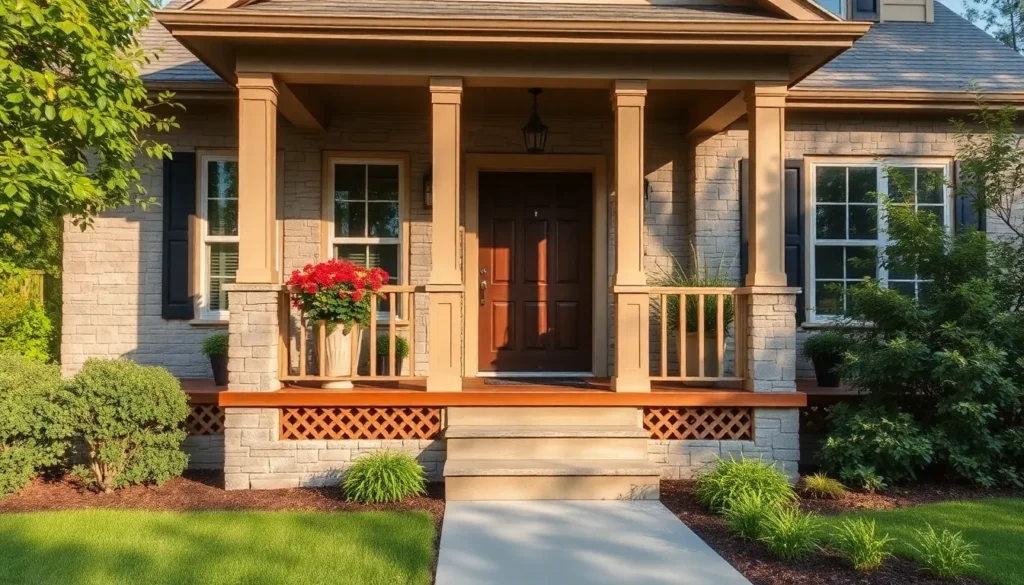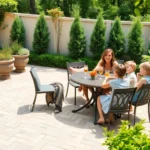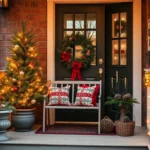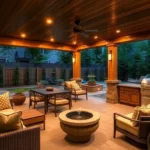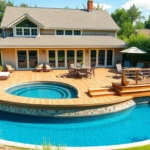Your front porch deserves more than just functional support – it needs style that makes a lasting first impression. We’ve all walked past homes where the porch skirting either catches our eye for all the right reasons or detracts from an otherwise beautiful exterior. The difference often lies in choosing the right skirting design that complements your home’s architecture while serving its practical purpose.
Whether you’re building a new porch or updating an existing one we understand that finding the perfect skirting solution can feel overwhelming. From classic lattice panels to modern horizontal slats there’s a industry of creative possibilities waiting to transform your porch’s foundation into a design feature.
We’ll explore innovative skirting ideas that balance aesthetics with functionality helping you create curb appeal that reflects your personal style. Ready to discover how the right porch skirting can elevate your home’s entire exterior?
Lattice Skirting: Classic Charm With Versatile Appeal
Lattice skirting remains our top choice for homeowners seeking timeless elegance that complements virtually any architectural style. This beloved option offers the perfect balance of coverage and airflow while maintaining visual interest beneath your porch.
Traditional Wood Lattice Options
Cedar lattice panels deliver natural beauty with exceptional durability for most climate conditions. We recommend cedar because it naturally resists rot and insects while developing an attractive weathered patina over time. Standard 4×8 foot panels cost between $25 to $45 each and install easily with basic carpentry skills.
Pressure treated pine lattice provides an economical alternative at $15 to $30 per panel. This option requires regular staining or painting every 2 to 3 years to maintain its appearance and prevent moisture damage. Many homeowners choose pine for budget conscious projects or temporary installations.
Redwood lattice panels offer premium quality with natural oils that resist weathering and decay. These panels typically cost $40 to $70 each but provide decades of service with minimal maintenance. We often see redwood chosen for high end homes where the rich color and grain patterns enhance overall curb appeal.
Vinyl Lattice for Low Maintenance
PVC lattice panels eliminate the need for painting or staining while maintaining consistent color for years. We appreciate that vinyl options resist fading, cracking, and warping in extreme weather conditions. Most manufacturers offer white, tan, and gray colors with prices ranging from $20 to $35 per panel.
Composite lattice materials combine recycled wood fibers with vinyl for enhanced strength and texture. These panels feel more like real wood while providing the maintenance benefits of synthetic materials. Installation costs remain similar to traditional options, but the long term savings make composite lattice increasingly popular.
UV resistant vinyl formulations prevent the chalky appearance that affected earlier synthetic lattice products. Modern vinyl lattice maintains its original color and flexibility for 15 to 20 years without replacement. We recommend checking manufacturer warranties before purchasing, as coverage varies significantly between brands.
Custom Lattice Patterns and Designs
Diagonal lattice configurations create ever-changing visual movement that draws attention upward toward your porch details. We suggest using 45 degree angles for traditional homes or experimenting with steeper angles for contemporary designs. Custom angles require additional cutting time but produce unique results that set your home apart.
Mixed spacing patterns combine standard 2 inch squares with larger 4 inch or 6 inch openings for varied texture. This approach works particularly well when you want to highlight exact porch features or create focal points beneath different sections. Professional installation ensures proper measurements and consistent spacing throughout the project.
Curved lattice elements add sophisticated curves to traditional rectangular panels through careful cutting and shaping. We often incorporate arched tops or scalloped edges that echo architectural details found elsewhere on the home. These custom touches typically increase installation costs by 30 to 50 percent but create truly distinctive porch skirting.
Stone Veneer Skirting: Elegant Foundation Enhancement
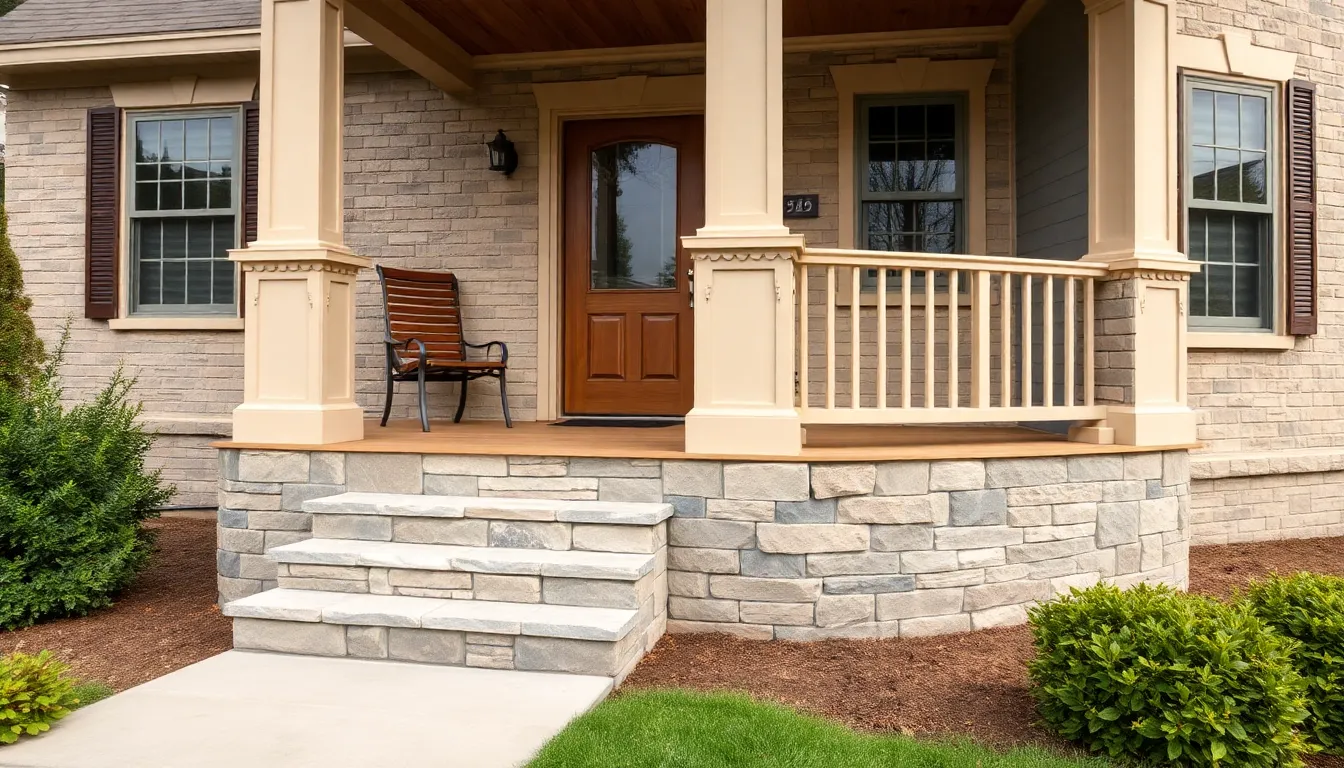
Stone veneer skirting transforms your front porch foundation into a sophisticated architectural feature that commands attention. This premium skirting option combines the timeless beauty of natural stone with modern installation techniques for lasting curb appeal.
Natural Stone Veneer Applications
Natural stone veneer wraps your porch foundation with authentic texture and earthy appeal that perfectly complements rustic and traditional home styles. We love how slate, limestone, and fieldstone varieties create stunning visual depth while maintaining the durability homeowners need for long term performance.
Accent walls and decorative pillars become focal points when crafted with natural stone veneer applications. These installations add character to otherwise plain porch foundations while creating seamless transitions between your home’s exterior and landscaping elements.
Textured surfaces from natural stone veneer provide organic variation that manufactured materials simply can’t replicate. Each piece tells its own story through unique color patterns and surface irregularities that develop naturally over thousands of years.
Manufactured Stone Benefits
Cost effectiveness makes manufactured stone veneer an attractive alternative to natural stone while delivering similar visual impact for your porch skirting project. We’ve found that homeowners save significantly on both material costs and installation expenses without compromising aesthetic quality.
Lightweight construction allows manufactured stone veneer to install easily on existing porch foundations without requiring additional structural support. This advantage reduces labor time and eliminates the need for foundation reinforcement that heavier natural stone might demand.
Consistent sizing and color matching simplify the installation process while ensuring uniform appearance across your entire porch foundation. Manufactured stone resists chipping and cracking better than many natural alternatives, providing enhanced longevity with minimal maintenance requirements.
Matching Stone to Home Architecture
Traditional and Craftsman style homes pair beautifully with rough cut stones in earth tones that emphasize natural texture and organic appeal. We recommend selecting stones that echo the color palette found in your roof materials and existing exterior elements for cohesive design flow.
Contemporary homes benefit from sleeker, uniform manufactured stones or lighter color options that complement modern architectural lines. These choices create clean transitions between your porch foundation and the home’s overall geometric design language.
Coordinating stone colors with your roof materials, siding, and landscaping ensures a unified exterior appearance that enhances property value. Strategic color matching creates visual harmony that makes your entire home exterior feel intentionally designed rather than assembled from random components.
Board and Batten Skirting: Timeless Farmhouse Style
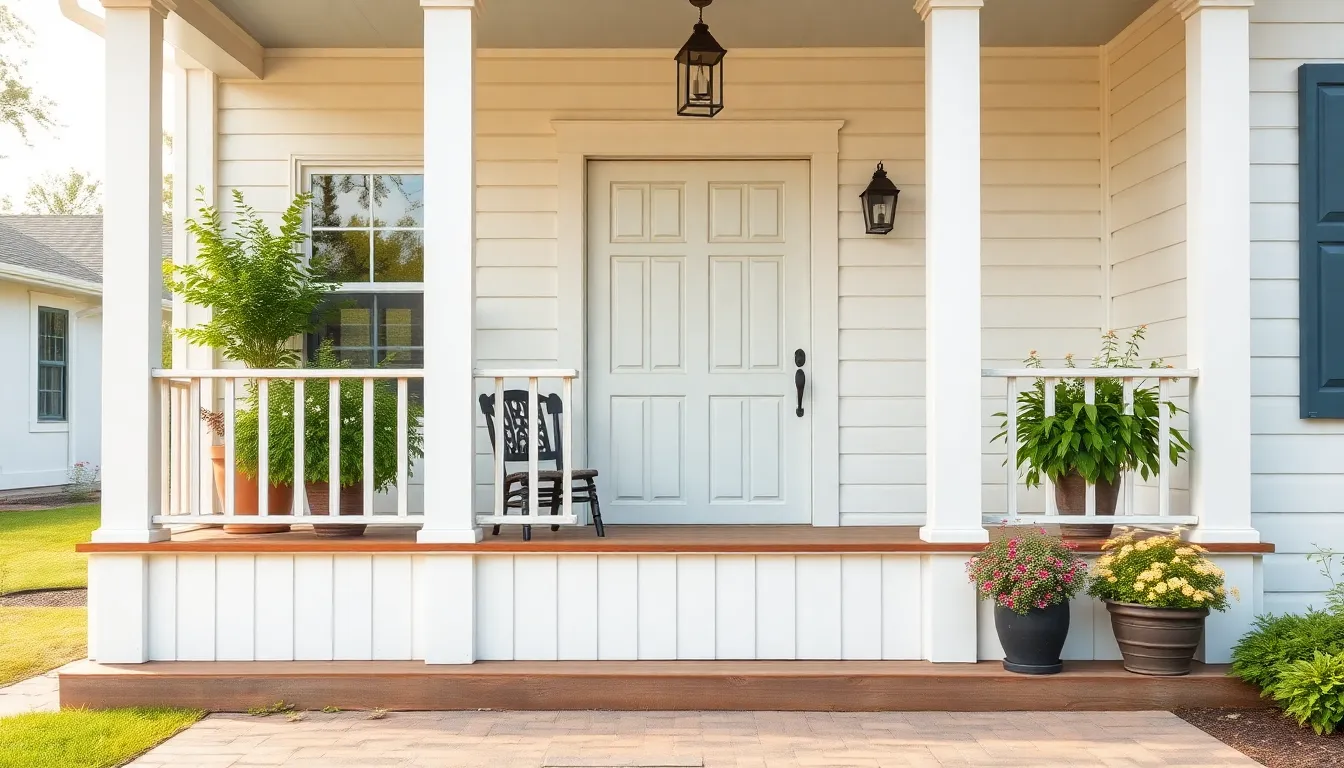
Board and batten skirting delivers that coveted farmhouse aesthetic we’re all seeking for our front porches. This classic design technique combines wide vertical boards with narrow battens covering the seams, creating depth and visual texture that elevates any porch foundation.
Vertical Board Installation Techniques
Vertical board installation creates an elegant foundation that draws the eye upward while maintaining that authentic farmhouse charm. We recommend starting with weather resistant materials like cedar, redwood, or pressure treated lumber to ensure your skirting withstands the elements year after year.
Spacing plays a crucial role in achieving the perfect visual balance. Most installations benefit from battens spaced 12 to 16 inches on center, creating consistent rhythm across your porch base. Each board should attach securely to a frame or ledger board positioned under the porch rim joist for maximum stability.
Proper ventilation behind the skirting prevents moisture buildup that could damage both your porch structure and the skirting materials. Small gaps or ventilation strips allow air circulation while maintaining the clean appearance of your board and batten design.
Horizontal Board Arrangements
Horizontal board skirting offers a contemporary twist on traditional porch foundations while maintaining versatility across different architectural styles. This orientation works particularly well with craftsman style homes and modern farmhouse designs where clean lines take precedence.
Installation options include tight fitting boards or rain screen style arrangements with small gaps between each horizontal piece. Staggering board ends adds visual interest and prevents the monotony that can occur with perfectly aligned horizontal lines.
Metal alternatives like corrugated aluminum provide durability for homeowners seeking low maintenance answers with sleek modern appeal. These horizontal metal options complement contemporary home designs while offering superior weather resistance compared to traditional wood materials.
Paint and Stain Color Combinations
Color selection transforms your board and batten skirting from functional necessity into striking design element that enhances your home’s curb appeal. White and off white paint maintains that classic farmhouse aesthetic while creating clean contrast against darker porch elements.
Dark colors like gray, black, or navy create dramatic visual impact that works exceptionally well when paired with light colored porch floors or railings. These bold choices make your porch skirting a standout architectural feature rather than background element.
| Color Choice | Best Application | Maintenance Level |
|---|---|---|
| White/Off-white paint | Classic farmhouse style | Moderate (shows dirt) |
| Dark stains (gray/black) | Modern contrast looks | Low (hides wear) |
| Natural wood stains | Rustic/traditional homes | Moderate (periodic refresh) |
| Cedar/redwood stains | Warm natural appeal | Low (natural resistance) |
Natural wood stains showcase grain patterns while adding warmth that complements cedar and redwood’s inherent beauty. Contrasting colors between your skirting and porch decking creates architectural interest that defines separate design elements within your overall porch composition.
UV protection in outdoor grade paints and stains extends color vibrancy and reduces maintenance frequency, making your investment in quality board and batten skirting last for years to come.
Brick Skirting: Durable and Distinguished Design
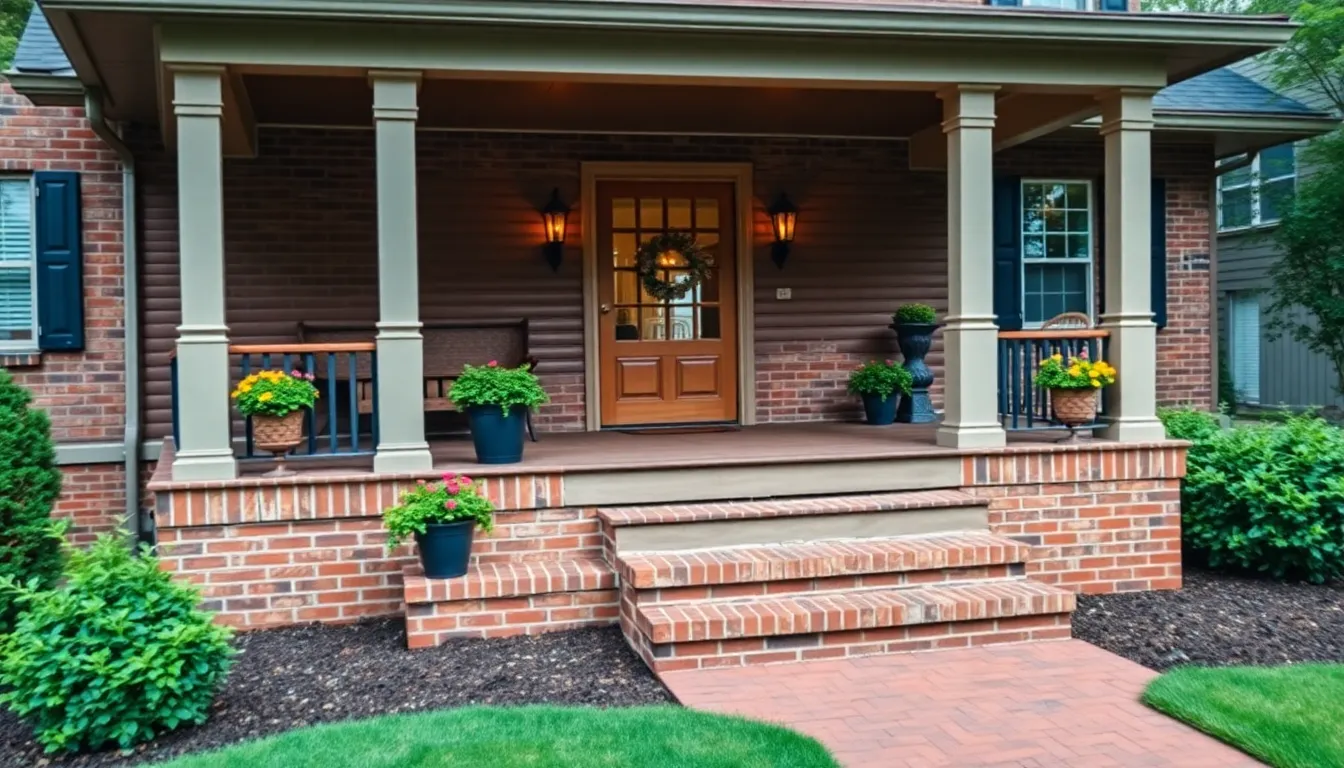
Brick skirting stands as one of the most enduring and sophisticated choices for front porch foundations. We’ll explore how this classic material combines exceptional durability with timeless visual appeal.
Traditional Red Brick Applications
Traditional red brick skirting delivers a classic, timeless appearance that beautifully complements wooden decks and natural outdoor environments. We find that red brick creates a sturdy foundation while adding an elegant finish to any porch design. This approach provides both functional protection and striking visual appeal that enhances the overall architectural character.
Red brick skirting balances exceptionally well with bright wooden decking materials. The warm tones create a sense of permanence and welcoming atmosphere that draws guests toward your entrance. We recommend this option for homeowners seeking a distinguished look that withstands changing design trends while maintaining its classic charm.
Painted Brick for Modern Appeal
Painted brick skirting transforms traditional materials into contemporary design elements while preserving their inherent durability. We often suggest neutral paint colors like white, gray, or black to achieve a clean, sleek appearance that suits modern and transitional home styles. This customization method allows you to unify your porch with other exterior architectural elements.
Painting brick skirting offers remarkable flexibility in matching your home’s existing color palette. We’ve seen homeowners successfully modernize their porch foundations by applying fresh paint that coordinates with shutters, trim, or siding colors. This approach delivers the structural benefits of brick while adapting to current design preferences.
Mixed Brick and Stone Combinations
Combining bricks with natural stones creates textured, visually rich foundations that convey both traditional craftsmanship and modern sophistication. We recommend multicolored brick and stone combinations that mimic stone wall appearances while maintaining geometric consistency. This hybrid approach works particularly well for larger porches or decks where you want a substantial, grounded aesthetic.
Mixed materials prevent the foundation from overpowering your overall porch design. We find that this combination technique adds architectural interest without competing with other decorative elements like railings or planters. The varied textures and colors create depth that enhances your home’s curb appeal while providing the weather resistance and low maintenance benefits that brick materials offer.
Metal Skirting: Contemporary and Weather-Resistant
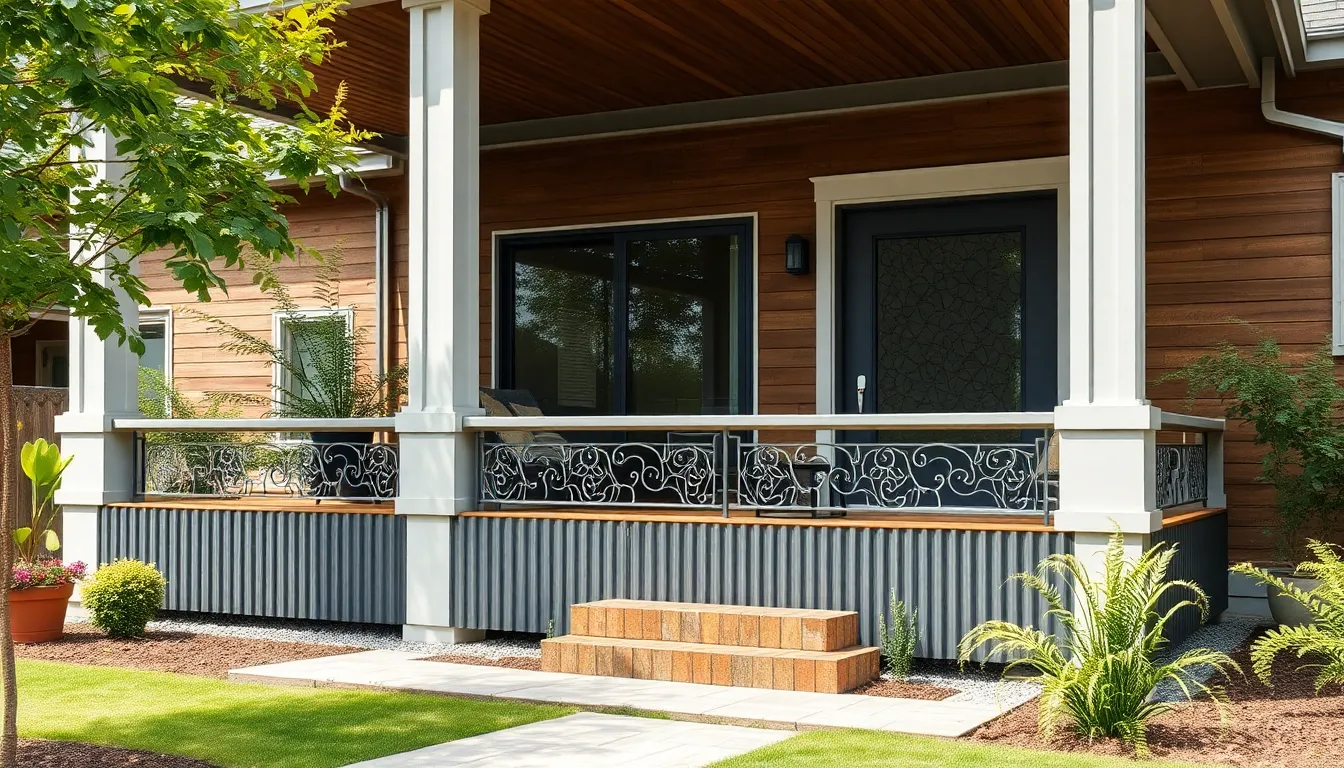
Metal skirting transforms your front porch with its sleek modern appearance and exceptional durability against harsh weather conditions. We recommend this low maintenance option for homeowners seeking contemporary style without the upkeep demands of traditional wood materials.
Corrugated Metal Panel Options
Corrugated metal panels create stunning visual texture through their distinctive horizontal ribbed pattern that adds industrial charm to your porch design. These lightweight aluminum panels resist rust and withstand extreme weather while delivering a sleek finish that complements contemporary architectural styles. We’ve found that corrugated panels work exceptionally well when you want skirting that resembles modern siding materials.
Installation becomes straightforward since corrugated panels attach directly to your porch frame using standard fasteners. The textured surface helps hide minor imperfections while providing excellent protection for the under porch area. Consider spacing panels slightly apart to allow natural ventilation while maintaining the clean horizontal lines that define this popular metal option.
Decorative Metal Screen Designs
Decorative metal screens offer the perfect balance between functionality and visual appeal through intricate lattice patterns or precision laser cut designs. These screens allow essential airflow to circulate beneath your porch while providing partial visibility and protection from debris. Metal lattice patterns mimic traditional wood designs but deliver superior longevity without regular maintenance requirements.
Laser cut screens showcase geometric patterns or custom designs that create striking shadow play when sunlight filters through the openings. We recommend selecting screen designs that complement your home’s architectural details while maintaining adequate ventilation for moisture control. The combination of protection and style makes decorative metal screens ideal for homeowners wanting sophisticated porch skirting.
Powder-Coated Finish Selections
Powder coated finishes provide exceptional durability by creating a weather resistant surface that resists fading, chipping, and corrosion over time. Black powder coating remains the most popular choice because it creates dramatic contrast against wood or composite decking materials while delivering a sleek modern appearance. These finishes maintain their vibrant color and smooth texture without requiring repainting or refinishing.
Multiple color options allow you to match your home’s exterior palette or create bold accent statements that enhance curb appeal. Powder coating bonds directly to the metal surface during a high temperature curing process that produces a finish significantly more durable than traditional paint applications. We’ve observed that powder coated metal skirting retains its appearance for years while requiring only occasional cleaning with soap and water.
Concrete Block Skirting: Affordable and Sturdy Solution
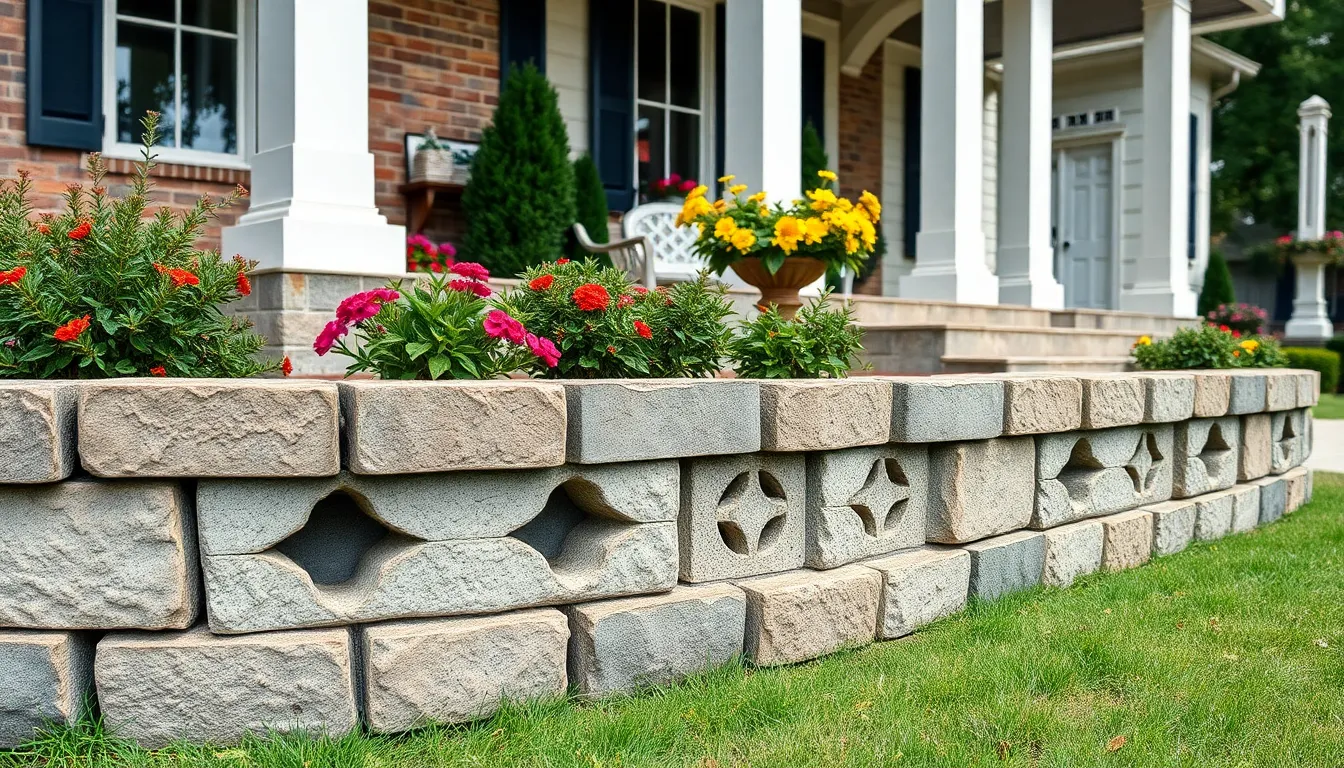
Concrete block skirting delivers exceptional value for homeowners seeking a cost-effective yet durable foundation enclosure. This sturdy material provides long-lasting protection while maintaining an attractive appearance that complements various architectural styles.
Standard Block Installation Methods
Foundation preparation forms the cornerstone of successful concrete block installation. We recommend starting with a level and compacted base that ensures proper drainage and stability for years to come.
Block laying requires careful attention to alignment and leveling during each course. Mortar application between blocks creates strong bonds, while staggered placement enhances structural integrity throughout the installation.
Ventilation considerations prevent moisture buildup beneath your porch. Strategic placement of vents or decorative hollow blocks allows essential airflow while maintaining the skirting’s protective function.
Reinforcement techniques using steel rebar or mesh provide additional structural support where needed. These materials integrate seamlessly within or behind the blocks to create a robust foundation enclosure that withstands weather and time.
Decorative Block Pattern Ideas
Ventilation blocks with geometric cutouts combine functionality with visual appeal. Breeze blocks featuring intricate patterns allow airflow while creating striking design elements that enhance your porch’s architectural character.
Textured surfaces transform standard concrete blocks into sophisticated design features. Split-face blocks offer natural stone-like appearances that complement rustic and traditional home styles beautifully.
Color treatments expand design possibilities through staining or painting applications. These finishing techniques allow blocks to match or contrast with existing porch trim and siding for cohesive curb appeal.
Brick-style arrangements create classic patterns using concrete blocks in running bond or Flemish bond configurations. These traditional masonry patterns add visual interest while maintaining the durability benefits of concrete construction.
Stucco and Paint Finishing Options
Stucco applications over concrete blocks create smooth or textured surfaces with exceptional weather resistance. This finishing method offers unlimited color options through tinting, allowing seamless integration with various home exteriors and architectural styles.
Paint treatments using high-quality masonry paint provide both protection and customization opportunities. Breathable exterior paints prevent moisture issues while delivering long-lasting color that enhances your porch’s overall appearance.
Combination approaches layer stucco and paint for polished, professional results. These dual treatments maximize durability while achieving refined aesthetics that complement contemporary and traditional home designs effectively.
Natural Material Skirting: Eco-Friendly Alternatives
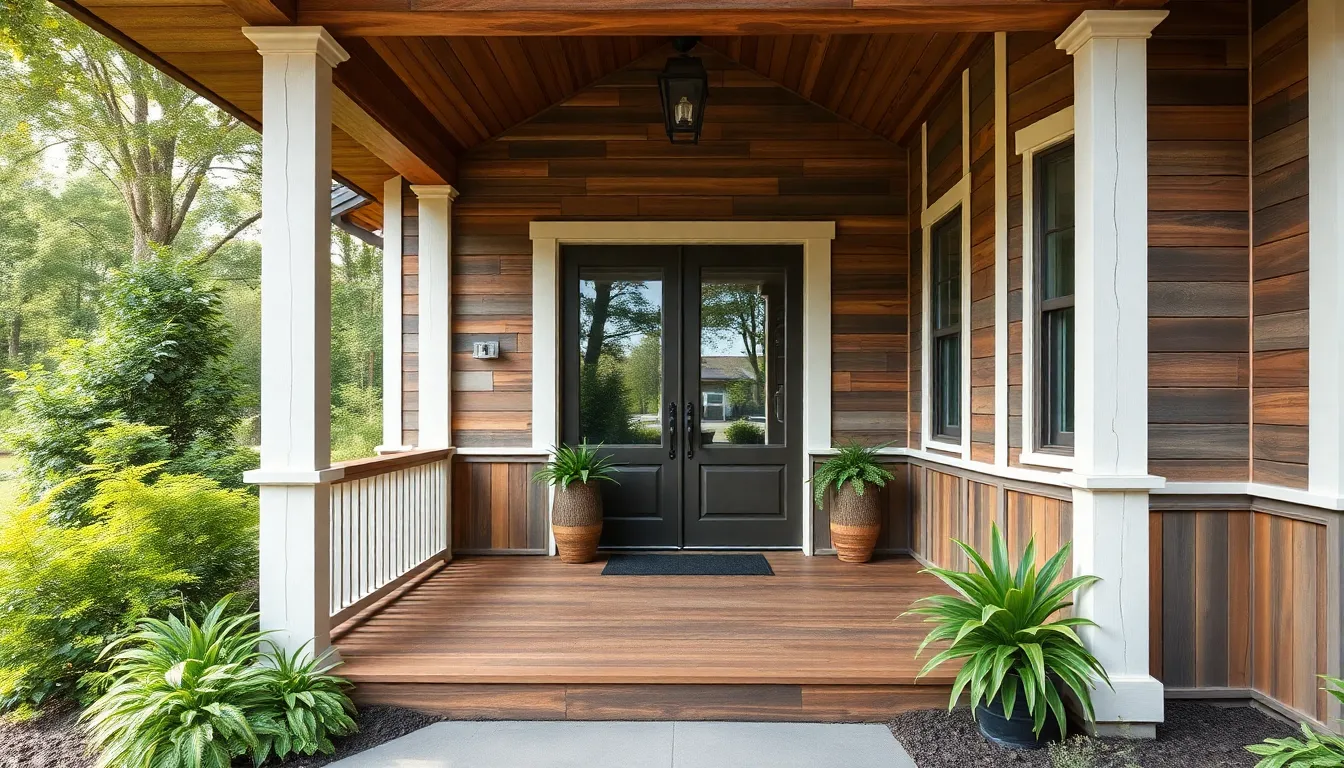
We’re excited to explore sustainable skirting options that combine environmental responsibility with stunning visual appeal. Natural materials offer homeowners the perfect opportunity to create eco-conscious designs while maintaining the durability and charm that front porch skirting demands.
Cedar Shake and Shingle Applications
Cedar shake and shingle skirting brings timeless rustic charm to your front porch foundation. This traditional natural material delivers exceptional durability thanks to its inherent resistance to decay and insect damage. Weather resistance comes naturally with cedar, making it an ideal choice for outdoor applications that face seasonal challenges.
Installation of cedar shakes creates beautiful texture variations that complement natural wood porch structures seamlessly. We love how cedar’s warm color tones blend effortlessly into outdoor environments while requiring minimal maintenance compared to other wood options. Overlapping shingle patterns add visual depth and provide excellent protection against moisture infiltration.
Cost considerations make cedar shakes a worthwhile investment since their natural properties eliminate the need for frequent treatments or replacements. Homeowners appreciate cedar’s ability to age gracefully, developing an attractive silver-gray patina over time that enhances the rustic aesthetic.
Bamboo Panel Installation
Bamboo skirting panels offer an exceptionally sustainable solution that’s both budget friendly and visually striking. Fast growing bamboo serves as a renewable resource that significantly reduces environmental impact compared to traditional lumber options. Lightweight reed panels make installation straightforward while providing excellent ventilation around your porch base.
Tropical aesthetics emerge naturally with bamboo’s unique grain patterns and warm golden tones. We find bamboo particularly suitable for homeowners seeking exotic design elements that reflect environmental consciousness. Panel installation requires minimal tools and can typically be completed in a single weekend project.
Durability surprises many homeowners since properly treated bamboo panels resist moisture and pest damage effectively. Ventilation benefits help prevent humidity buildup under your porch while the natural spacing between bamboo reeds promotes healthy airflow.
Reclaimed Wood Creative Uses
Reclaimed wood skirting transforms salvaged materials into stunning design statements that reduce waste while adding character. Weathered textures from old buildings, barns, and pallets create unique grain patterns that can’t be replicated with new lumber. Each piece tells a story through varied colors, nail holes, and natural aging that adds authentic charm to your porch foundation.
Creative arrangements using reclaimed wood range from horizontal plank installations to custom lattice designs that showcase the material’s history. We encourage mixing different wood types and ages to create visually interesting patterns that serve as conversation starters. Vertical board configurations work particularly well when you want to emphasize height and create clean lines.
Environmental benefits multiply when you choose reclaimed wood since you’re preventing usable materials from entering landfills. Custom panels can incorporate decorative cutouts or mixed width planks that highlight the wood’s unique characteristics while providing necessary ventilation for your porch area.
Combination Skirting: Mixed Materials for Unique Appeal
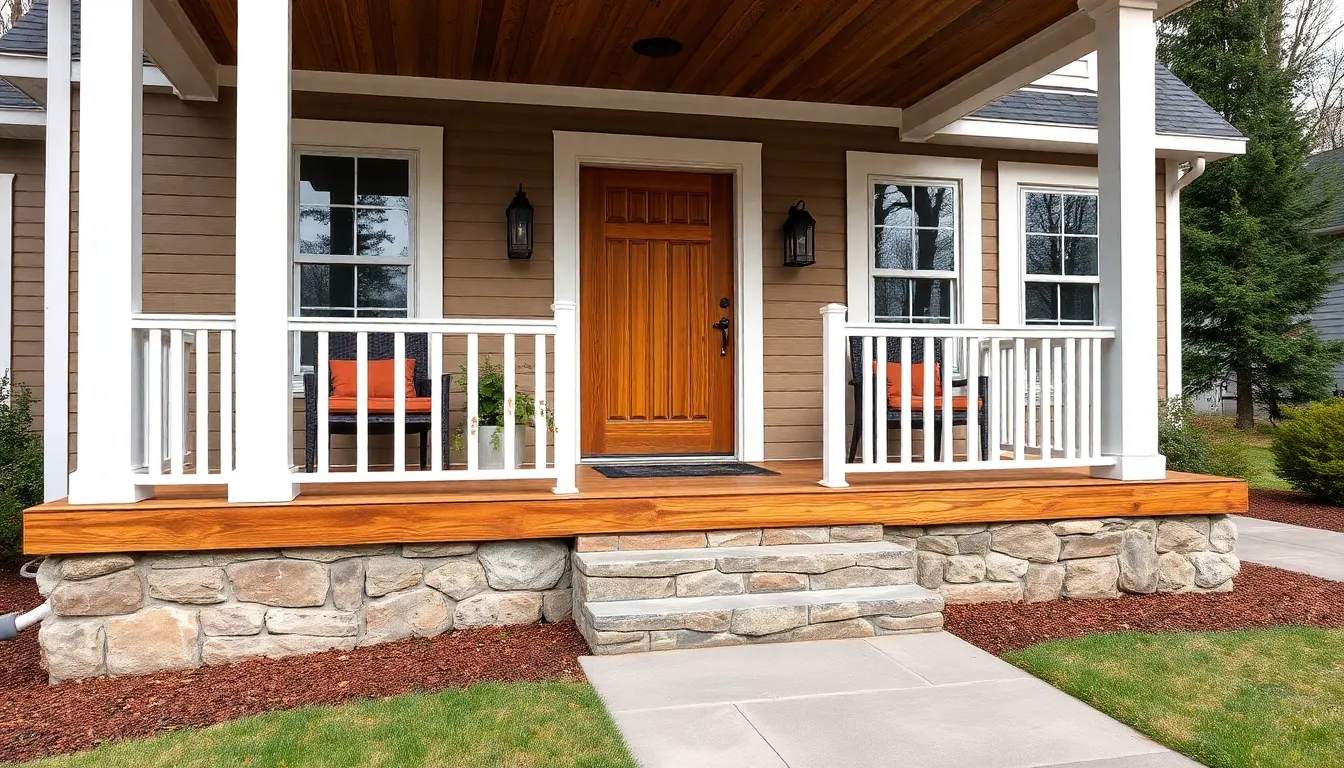
Combining different materials creates stunning visual depth while maximizing the functional benefits of each component. We’ve found that mixed material approaches deliver exceptional curb appeal and enhanced structural performance.
Stone and Wood Pairings
Stone and wood combinations deliver a sturdy, long-lasting aesthetic that seamlessly blends traditional charm with contemporary elegance. Natural stone paired with wooden deck elements creates an organic foundation that enhances your porch’s rustic appeal while conveying durability and security.
Multicolored bricks offer one approach, providing geometric patterns when using uniformly shaped pieces or organic textures with mixed stone varieties. Wood complements stone’s solid texture by adding visual warmth that balances the masonry’s substantial presence. Cedar or redwood planks work exceptionally well with natural fieldstone, while pressure-treated lumber pairs beautifully with manufactured stone veneer for cost-effective installations.
Installation requires proper moisture barriers between materials to prevent wood deterioration. We recommend using stainless steel fasteners to avoid corrosion and ensure long-term structural integrity.
Metal and Brick Combinations
Metal skirting combined with brick offers a modern twist that transforms traditional materials into contemporary design statements. Corrugated aluminum and metal lattice panels provide weather-resistant answers that require minimal maintenance while contrasting beautifully with brick textures.
Black metal lattice creates visually striking effects when paired with warm brick tones, merging industrial durability with classic masonry appeal. Horizontal metal elements add sleekness that suits modern architectural styles, while maintaining the timeless elegance that brick provides. Powder-coated finishes enhance color retention and resist fading, ensuring your combination skirting maintains its visual impact for years.
Weather resistance becomes a major advantage with these pairings, as metal components shed moisture while brick provides thermal mass and structural stability.
Lattice and Solid Panel Mixes
Lattice panels combined with solid materials create interesting textural contrasts while providing flexible privacy options. Metal lattice offers superior durability compared to wood alternatives, especially when combined with PVC or composite solid panels for balanced aesthetics and easy maintenance.
Solid panels protect against debris and pests while lattice sections allow essential ventilation and access to underneath areas. PVC wraps and composite finishes deliver clean appearances without requiring regular painting or staining. Wood lattice can complement stone or brick solid sections for rustic combinations that highlight natural material diversity.
Ventilation considerations become crucial with mixed approaches, as solid sections may trap moisture if not properly designed with adequate airflow channels. Strategic placement of lattice sections ensures proper air circulation while maintaining the desired visual balance between open and closed elements.
Decorative Screen Skirting: Artistic and Functional
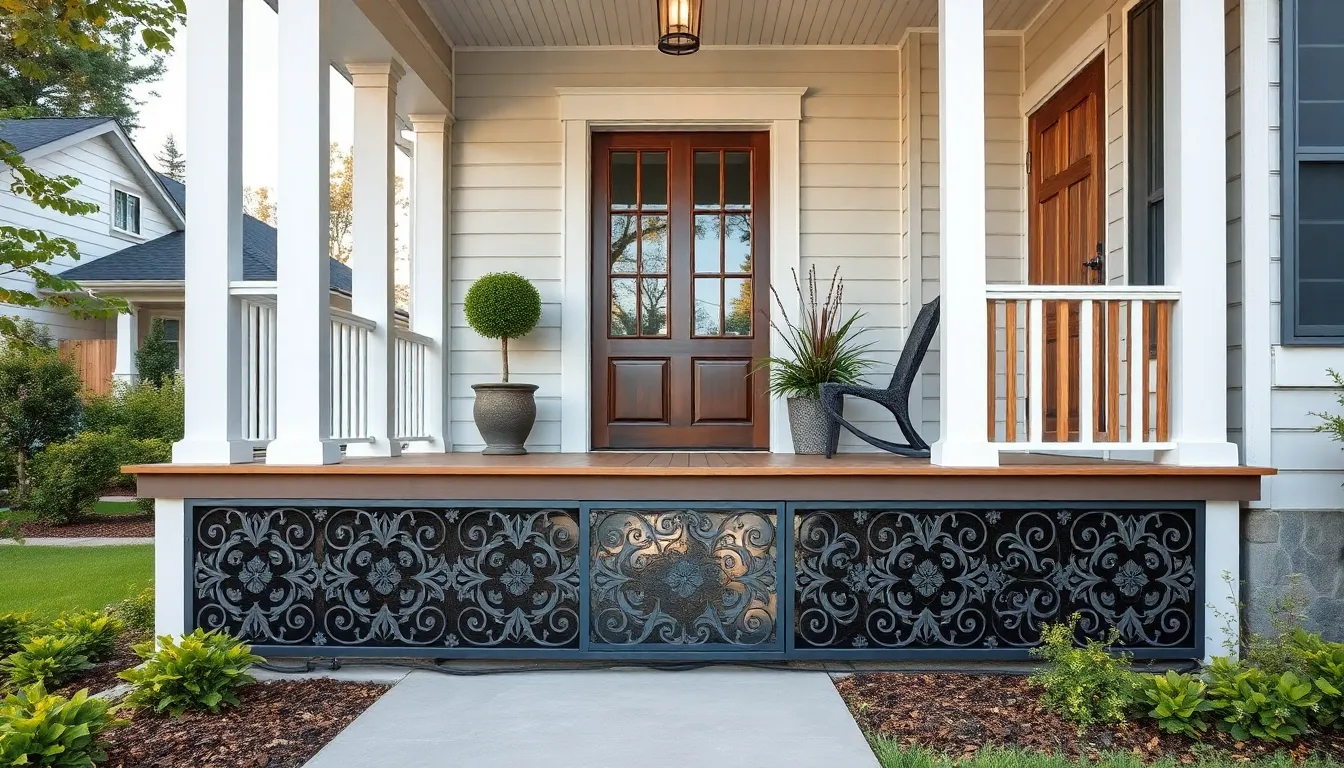
Screen skirting transforms ordinary porch foundations into stunning architectural features that blend artistic design with practical functionality. We’ll explore sophisticated options that create visual interest while maintaining proper airflow beneath your porch.
Laser-Cut Metal Screen Patterns
Laser-cut metal screens deliver exceptional durability with intricate artistic patterns that elevate your porch’s aesthetic appeal. These precision-crafted panels resist weathering and require minimal maintenance compared to traditional materials, making them ideal for homeowners seeking long-term value.
Black metal lattice panels provide classic elegance with modern resilience, creating sophisticated visual barriers that complement various architectural styles. Manufacturers offer custom pattern options ranging from geometric designs to nature-inspired motifs, allowing you to personalize your porch’s appearance.
Corrugated aluminum panels create sleek, contemporary aesthetics that mimic traditional siding while adding textural interest and horizontal visual lines. This material choice combines weather protection with artistic flair, ensuring your investment withstands seasonal changes without compromising style.
Wooden Screen Panel Designs
Wooden screen panels bring natural warmth and versatility to porch foundations, offering countless customization possibilities through staining, painting, and decorative cutout techniques. Cedar, redwood, and pressure-treated pine each provide unique grain patterns and color variations that enhance your home’s exterior character.
Lattice arrangements create traditional charm while allowing partial visibility and airflow beneath the porch structure. We recommend coordinating wooden skirting with existing deck elements to achieve a harmonious, cohesive appearance that flows naturally with your home’s design.
Decorative wooden cutouts add personalized charm through custom patterns that reflect your style preferences, from simple geometric shapes to intricate botanical designs. But, wooden materials require regular maintenance including staining or painting every 2-3 years to prevent weathering and extend their lifespan.
Privacy Versus Ventilation Balance
Effective screen skirting balances privacy needs with essential air circulation to prevent moisture buildup and mold growth beneath your porch. Decorative panels and lattice designs provide partial screening that shields the under-porch area while maintaining adequate airflow for structural health.
Metal screens with strategic perforations ensure proper ventilation without sacrificing privacy, offering customizable opening sizes based on your exact climate requirements. Composite and polypropylene materials resist warping and splitting while providing consistent airflow patterns that protect your porch’s foundation.
Solid skirting materials like brick or stone offer maximum privacy but reduce ventilation significantly, requiring careful consideration of your local climate conditions and moisture levels. We recommend incorporating ventilation gaps or removable panels in solid designs to maintain proper air circulation year-round.
Conclusion
We’ve explored an impressive array of front porch skirting options that can transform your home’s exterior from ordinary to extraordinary. Whether you’re drawn to the timeless appeal of lattice panels the rustic charm of cedar shake or the modern sophistication of laser-cut metal screens there’s a perfect solution waiting for your porch.
The key to successful skirting lies in balancing aesthetics with functionality while considering your home’s architectural style and your maintenance preferences. From budget-friendly concrete blocks to premium stone veneer each material offers unique benefits that can enhance your curb appeal.
Remember that the best skirting choice is one that reflects your personal style while providing the durability and ventilation your porch foundation needs. With these diverse options at your disposal you’re well-equipped to create a stunning first impression that welcomes guests and adds lasting value to your home.
Frequently Asked Questions
What is porch skirting and why is it important?
Porch skirting is a decorative and functional covering that conceals the space beneath a porch while enhancing your home’s curb appeal. It provides structural support, prevents moisture buildup, and creates a polished first impression. Skirting also helps protect the area under your porch from weather elements and pests while contributing to your home’s overall aesthetic style.
What are the most popular types of porch skirting materials?
The most popular porch skirting materials include lattice panels (wood, vinyl, or composite), stone veneer, board and batten, brick, metal screens, and concrete blocks. Each material offers different benefits in terms of durability, maintenance requirements, cost, and aesthetic appeal. The choice depends on your home’s architectural style, budget, and personal preferences.
How much does porch skirting typically cost?
Porch skirting costs vary significantly based on material choice. Budget-friendly options like vinyl lattice or concrete blocks range from $3-8 per square foot. Mid-range materials like cedar or composite cost $8-15 per square foot. Premium options such as natural stone veneer or custom metal screens can cost $15-30+ per square foot, not including installation.
What’s the difference between natural and manufactured stone veneer?
Natural stone veneer offers authentic texture and unique variations but costs more and requires professional installation due to its weight. Manufactured stone veneer provides similar aesthetic appeal at a lower cost, is lightweight and easier to install, and offers consistent patterns. Both options provide excellent durability and low maintenance requirements.
How do I choose the right color for my porch skirting?
Select colors that complement your home’s exterior palette and architectural style. Neutral tones like white, beige, or gray offer versatility and timeless appeal. Bold colors can create striking contrasts but may require more frequent maintenance. Consider UV-resistant paints and stains to maintain color vibrancy over time, especially for wood materials.
What is board and batten skirting?
Board and batten skirting features wide vertical boards combined with narrow strips (battens) that cover the seams, creating a classic farmhouse aesthetic. This style works well with various architectural designs and can be customized with different spacing patterns. It’s typically made from weather-resistant materials like cedar or pressure-treated lumber.
Can I mix different materials for porch skirting?
Yes, combination skirting using mixed materials creates unique visual appeal and enhanced performance. Popular combinations include stone and wood pairings, metal and brick designs, or lattice mixed with solid panels. This approach allows you to balance cost, maintenance, and aesthetic preferences while creating a custom look that complements your home’s style.
How important is ventilation in porch skirting design?
Proper ventilation is crucial for preventing moisture buildup, mold growth, and structural damage beneath your porch. Most skirting materials naturally provide some airflow, but solid materials like concrete blocks may require deliberate ventilation gaps or vents. Adequate ventilation helps maintain the structural health of your porch and prevents costly repairs.
What are decorative screen skirting options?
Decorative screen skirting includes laser-cut metal screens with intricate patterns and wooden screen panels that offer natural warmth. These options transform ordinary porch foundations into artistic architectural features while maintaining functionality. They provide excellent ventilation, customizable privacy levels, and can be designed to match your home’s specific style requirements.
How do I maintain different types of porch skirting?
Maintenance varies by material: wood skirting requires periodic staining or painting and inspection for rot; vinyl and composite need occasional cleaning with soap and water; stone and brick require minimal maintenance but may need repointing; metal skirting should be checked for rust and may need touch-up painting. Regular cleaning and inspection help extend the life of any skirting material.

